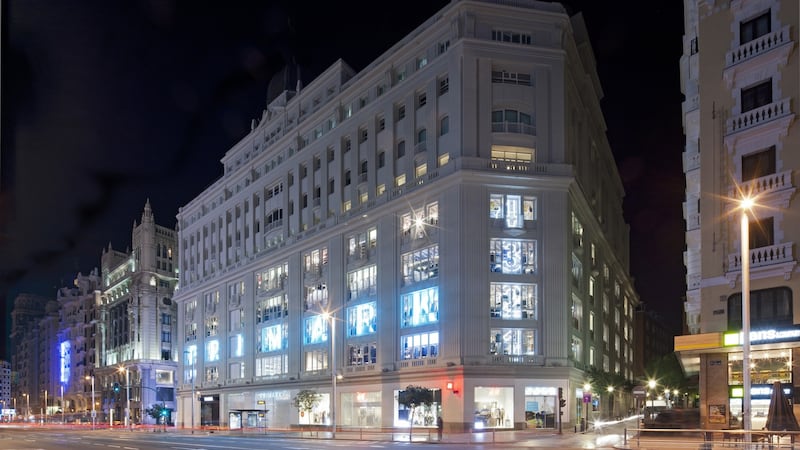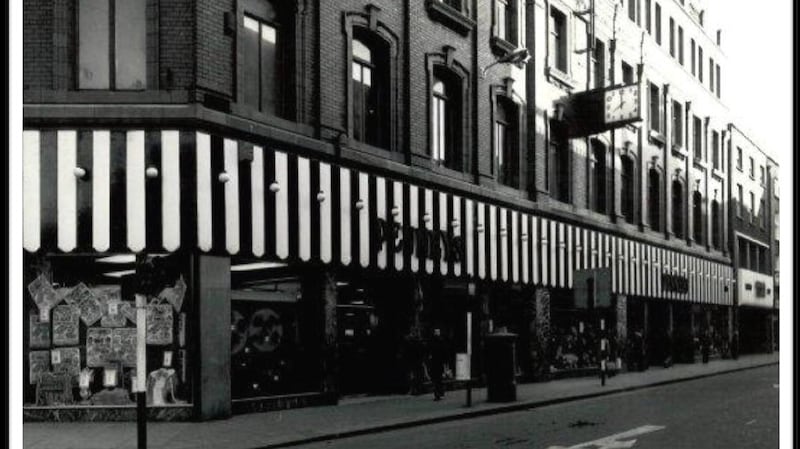Next week, on April 14th, Primark will open its first store in Italy. The store is in Arese, about 12km from fashion hotspot Milan, in a former Alfa Romeo factory now transformed into what has been hailed as the largest shopping centre in the country.
Following the success of its first US store in Boston last September and with plans for a further six in the States this year, there seems no stop to the Irish fashion juggernaut. So where did it all begin?
"What the heck is Primark?" was the query of a bewildered Boston Globe correspondent ahead of the retailer's US opening last year echoing the generally mystified response to a brand then unknown in the US.


Familiar here in Ireland – where it is known as Penneys – and as Primark all over Europe, it is to fashion what Ryanair is to aviation, an Irish success story spreading affordable fashion right across the continent. With seven times more employees though and more than 7.4 million followers on social media, it far outpaces the aviation company.
One of the most powerful people in Irish retailing, board member Breege O’Donoghue the director responsible for new markets who last month received the Légion d’honneur in Dublin from the French ambassador, Jean-Pierre Thébault has been central with other top executives to the dramatic development of the company. It has grown from 17 stores when she joined in the mid-1970s to its present number of 304 in 10 countries, 62,000 employees and annual profits in 2014 of €808 million.
CEO Paul Marchant who joined in 2009 describes the years 1969, 1974, 2006 and 2015 as "pivotal moments" in the history of the company. It all began in 1969 when Arthur Ryan, "a man with retailing flowing through his blood" who was poached by Garry Weston from Dunnes Stores, joined forces with finance director Paddy Prior to open the first store in Mary Street for parent company ABF (Associated British Foods) called Penneys. It offered "pile-them-high, sell-them-cheap" clothes at rock-bottom prices. Later Prior and Ryan along with Seamus Halford and Breege O'Donoghue became known as the gang of four who were to propel the company into its ambitious UK and European expansion.
In terms of fashion, Penneys became particularly well known during the 1980s and '90s by bargain hunters for its wide offering of swimwear, for example, under the guidance of savvy buyers like Triona McGinley and Anne Marie Cregan.
Over the years, its fashion credibility expanded with more adventurous forays into high fashion at low prices and when it opened its first UK store in 1974 it was forced to change its name to Primark because the US company JC Penney had trademarked the name in the UK. The big breakthrough, however, came in 2005 when Primark bought 42 Littlewoods high street stores in the UK in a deal worth £409 million from the Barclay Brothers, owners of the Telegraph newspaper.
The opening of its flagship in Oxford Street in 2007 made headlines. Three thousand people – many of whom had queued from early in the morning – caused a stampede and a number were injured. Marchant, then working in New Look whose office was diagonally opposite the store remembers it well. "I watched from my desk and saw already a big crowd queuing at 6.45 in the morning. It was the dead end of Oxford Street and previous retailers like C & A and Allders hadn't managed to make it work, so it was a big risk". In the first 10 days of trading one million garments were sold.
The first move outside the UK and Ireland took place 10 years ago with the opening of a store in Spain on the outskirts of Madrid.
“It was our first foray into continental Europe and a big life-changing moment; it changed the whole perception of the brand; not only the way in which we were perceived, but the way we looked at ourselves,” Marchant says.
From then on, expansion continued apace; stores in Germany and the Netherlands opened in 2008, in Portugal and Belgium in 2009 with Austria following in 2012, and France in 2013. "Every store we open is an event and it's no mean thing. We put a lot of time and effort into opening in the right way and embracing the new community", says Marchant.
He says the company contacts local organisations, such as job centres, charities, councils, colleges, universities and mayors before the openings. “Management teams are a blend of Primark experience and top-tier knowledge of the company’s DNA with local expertise – that combination is very powerful”, he says.
However, in April 2013, the human cost of high-volume, low-margin retailing came into sharp focus when the Rana Plaza building in Dhaka, Bangladesh, collapsed killing more than a thousand people and shedding light on the conditions of factory workers in that country's $20 billion garment industry. Factory owners, governments and retailers such as Primark, H&M and Zara moved to try to ensure improved safety and working standards with an accord agreed with 10 labour unions.
To date Primark has paid $14m in aid and compensation and has conducted more than 2,000 factory audits in the past two years. "We work closely with factories in Bangladesh and would never reject one if it has a remedial plan. We can only work so hard at improvements and, provided they are willing to improve, we will continue to work with them," says Marchant, adding that Primark manufactures in China, India, Pakistan and in growing hubs in Vietnam, Cambodia and Myanmar as well as in Turkey.
It has been estimated, however, that doubling the minimum wage in Bangladesh currently $68 a month would only add 10 to 12 cents to the cost of making a basic T-shirt.
Taking on the US market worth $200 billion was the big challenge in 2015 demanding an initial capital investment of $340 million. “We’re a volume business. We sell 300 million pairs of socks and 150 million T-shirts a year. We have a very efficient supply chain and no major overheads,” O’Donoghue told Reuters in July 2014.
In the event, the Boston store was another venture that appears to have succeeded with a further six US stores on track to open this year.
“When it comes to fashion, US consumers want the same trends but it is more about the mix and you only really know that when you start trading” says Marchant. They learned that US taste meant a demand for outerwear like coats and jackets but not flannel pyjamas, for example.
“Even though the weather is colder they don’t want the heavy nightwear that the Spanish like because of central heating. In Spain where it is 16 degrees with marble flooring, pyjamas are big sellers. It’s about lifestyle and how they live their lives.”
Sizing is another issue and having banked on larger American sizes, because of the student and Asian population in Boston, “we didn’t have enough of the smaller sizes – we saw more diverse size ratios”.
Expansion continues along the populous (55m) north eastern corridor of the US from Massachusetts to Philadelphia in the south with a distribution depot in Pennsylvania. So far its success has been attributed to targeting shoppers who are "European" in their fashion outlook, no mean achievement given that UK retailers like Marks & Spencer, WH Smith, Sainsburys and Tesco have all come unstuck in the US.
The growth in store size and the expansion of the product offering go hand in hand, says Marchant with significant expansion of sportswear across men’s and women’s wear launched three years ago, the introduction of beauty products, associated accessories and continued investment in customer experience with free Wifi, seating and coffee shops in many new stores in the UK and Ireland.
“Store staff are critical, they deal with customers at the coal face”, he says. In February Mandate trade union members at Penneys got a pay increase of 4.5 per cent.
Primark’s fashion follows trends, but is primarily casual with a large offering of basic staples like T-shirts, jeans, socks, shirts etc. “We watch how real people are wearing clothes - we watch celebrities, bloggers and freestylers,” says one buyer.
Fashion hounds will see the influences of laidback street designers like Isabel Marant, for example, but there have also been high-profile collaborations with Harris Tweed and Molloy & Son's Donegal tweeds in menswear.
Some of my own recent finds have included cashmere sweaters; quilted, shapely winter jackets; black gilets and khaki dresses, although the smell of cheap footwear in the stores can be off-putting.
Critics argue that fast fashion like that of Primark contributes to environmental waste and pollution and I put it to Marchant that there is a growing concern about the impact of disposable fashion on the planet.
“I don’t like the phrase disposable fashion – I think it is a myth that the consumer wears things once or twice and then throws them away. I don’t buy that, it is a misleading assumption. We develop products with longevity – we don’t want them to be thrown away.”
He also adds that Primark is currently conducting recycling trials with drop-off points in a handful of stores. "All of our returns and our faulty goods are given to the Newlife Foundation charity, a UK business which takes all returns for resale – we are a significant contributor".
As for the implications of Brexit, he will not be drawn one way or the other, but does concede that any curtailment of the free movement of goods in Europe or introduction of extra tariffs would certainly increase costs.
“If Britain did leave there would be a long period of disengagement like the introduction of the euro, so there would be time to consider what to do.” Out of 301 stores in Europe, 168 are in the UK representing more than 32,000 employees.
There are now seven stores in France “going like trains”, according to O’Donoghue and turnover in Spain has hit €1.7 billion. In the meantime, Italy is the last bit of central Europe to be conquered “so we are clearly excited about this, particularly with the link to Milan and the fashion industry. What we are here to do is to respond to the demands of our consumers. We make people look and feel good for not a lot of money. The fact that they can dress head to toe for a reasonable amount is something of which we can be proud,” says Marchant.
Selling fashion, it has been said, is like selling fish – the fresher the better. A summer dress like the long one shown here from the spring collections will hit the street – or the beach – while yesterday’s catch may be left on the shelves. Time will tell if Italy gets hooked like all the other European countries on Primark too.


















